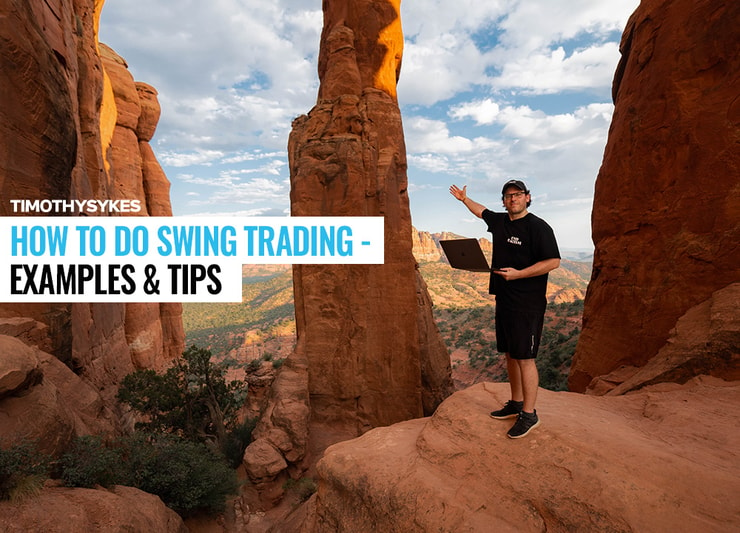Swing trading is a popular trading strategy that capitalizes on the natural ebb and flow of the markets. It’s a strategy that requires patience, discipline, and a keen understanding of market trends. But when done right, it can offer significant returns. In this article, we’ll delve into the world of swing trading, offering tips, strategies, and insights to help you navigate this exciting trading landscape.
Swing trading is a bit more accessible to new traders than day trading. Its strategies are easier to grasp, and it doesn’t require the same split-second entry decisions as day trading.
For some traders, it’s a great way to ease into trading. It can help you build good habits that will serve you no matter which direction your future in the market takes you.
Whether you’re looking to diversify your trading strategy or delve into swing trading for the first time, read on for a comprehensive guide to swing trading!
Table of Contents
- 1 What Is Swing Trading?
- 2 Preparing to Swing Trade
- 3 Applying Your Strategy
- 4 Taking Profits and Managing Losses
- 5 How Can I Start Swing Trading?
- 6 How Much Money Can I Make Swing Trading?
- 7 Is Swing Trading Risky?
- 8 Swing Trading vs. Long-Term Position Trading
- 9 Swing Trading Strategy: Adopt or Avoid?
- 10 Key Takeaways
What Is Swing Trading?

Swing trading is a strategy that traders use to take advantage of price swings in the market. Swing traders may hold positions for a few days to several weeks, following the momentum of short- to medium-term market trends.
The essence of swing trading lies in identifying the beginning of a specific price movement, and entering the trade then.
It’s not the same as value investing; swing traders buy a stock and aim to sell it in most cases. A swing trader rides a trend until they get the results they’re targeting — or until prices drop below their risk.
Swing trading requires patience, discipline, and a solid understanding of market trends and stock charts. With the right approach and mindset, it can be a profitable trading strategy.
To truly excel in swing trading, it’s crucial to understand the basics of day trading as well. This is because the two strategies often complement each other, and knowledge in both areas can enhance your trading skills. If you’re interested in learning more about day trading, check out this comprehensive guide on day trading basics.
Advantages of Swing Trading
Swing trading offers several advantages. First, it allows traders to make profits from short-term price movements, which are often overlooked by long-term investors. This means that swing traders can capitalize on opportunities that other traders might miss.
Second, swing trading is flexible. It doesn’t require constant monitoring of the markets, making it a good option for those who can’t or don’t want to spend their entire day in front of a computer screen. You can do your analysis, set your trades, and then go about your day.
Finally, swing trading can offer significant returns. While it’s not without risk, the potential for profit is substantial. With the right strategy and risk management, swing trading can be a lucrative way to trade the markets.
To capitalize on these advantages, it’s important to have a solid swing trading strategy. If you’re interested in developing or refining your strategy, consider reading this article on swing trading strategy.
Difference Between Swing Trading and Day Trading
Swing trading and day trading are two different beasts. While both involve making trades based on short-term price movements, the time frames and strategy involved are different.
Day trading, as the name suggests, involves making trades within a single trading day. Day traders aim to profit from small price movements in highly liquid stocks or currencies.
Swing traders hold positions for several days to weeks, aiming to profit from larger price swings. They’re not looking for a quick profit; they’re looking for a trend that they can ride for a significant gain.
While both strategies can be profitable, they require different skills and mindsets. Day trading requires quick decision-making and constant monitoring of the markets, while swing trading requires patience and a keen eye for trends.
Regardless of the strategy you choose, having a reliable trading platform is crucial. It can significantly enhance your trading experience and increase your chances of success. If you’re looking for a reliable platform, consider checking out this article on the best trading platform for day traders.
Preparing to Swing Trade

Before you dive into swing trading, it’s crucial to prepare adequately. This involves conducting thorough market research, setting clear and realistic trading goals, developing a robust trading plan, and gaining a deep understanding of the markets you intend to trade in. Preparation is key to successful swing trading.
Do Your Research
Before you dive into swing trading, you need to do your homework. This means understanding the markets you’re trading in, learning about different trading strategies, and staying up-to-date with market news and trends.
Research is not a one-time thing. It’s an ongoing process. The markets are constantly changing, and what worked yesterday might not work today. So, keep learning, keep adapting, and keep growing as a trader.
Set Your Goals
What do you want to achieve with swing trading? Are you looking for a steady income, or are you hoping to make a big profit? Your goals will influence your trading strategy, so it’s important to be clear about what you want.
Remember, though, that trading is not a guaranteed way to make money. It’s possible to lose money, especially if you’re new to trading. So, set realistic goals, and don’t risk more than you can afford to lose.
Develop a Plan and Strategy
Once you’ve done your research and set your goals, it’s time to develop a trading plan and strategy. This should include things like what markets you’ll trade in, what indicators you’ll use to identify trading opportunities, and how you’ll manage your risk.
Your trading plan is your roadmap. It guides your trading decisions and helps you stay focused and disciplined. Without a plan, you’re just gambling.
There are a lot of different ways to build a swing trading strategy. One of my favorites is weekend swing trading.
Check out my Weekend Profits program to learn more about this powerful strategy!
Understand the Markets You’re Trading In
Understanding the markets you’re trading in is crucial. This means knowing how different factors can affect the price of the assets you’re trading, and understanding the market trends and patterns.
Different markets have different characteristics and behave in different ways. For example, the stock market is influenced by factors like company earnings and economic indicators, while the forex market is influenced by factors like interest rates and geopolitical events.
Applying Your Strategy

Once you’ve prepared, it’s time to apply your swing trading strategy. This involves analyzing technical indicators, utilizing fundamental analysis tools, making informed trades — and knowing when to exit!
Analyze Technical Indicators
Technical indicators are tools that traders use to analyze price trends and patterns. They can help you identify potential trading opportunities and make informed trading decisions.
There are many different technical indicators, each with its own strengths and weaknesses. Some of the most popular ones include moving averages, relative strength index (RSI), and Bollinger Bands.
I use StocksToTrade for doing technical analysis. I helped design it to target the type of quick-changing data that traders rely on…
It has the trading indicators, dynamic charts, and stock screening capabilities that traders like me look for in a platform. It also has a selection of add-on alerts services, so you can stay ahead of the curve.
Grab your 14-day StocksToTrade trial today — it’s only $7!
Use Fundamental Analysis Tools

While technical analysis focuses on price trends and patterns, fundamental analysis looks at the underlying factors that affect the price of an asset. The stocks I trade have sketchy fundamentals — but I still know them.
These tools should be used in conjunction with other tools and strategies, not in isolation.
Make Trades and Close Positions When Necessary
Once you’ve identified a potential trading opportunity, it’s time to make a trade. But that’s not the most important part of the transaction…
You need to close your position to lock in profits or cut losses. It’s an important part of risk management, and it’s something that every trader needs to master.
Monitor Open Positions Regularly
Once you’ve opened a position, it’s important to monitor it regularly.
Monitoring your positions allows you to react quickly to any changes in the market. If the market moves in your favor, you might want to close your position to lock in profits. If the market moves against you, you might want to close your position to cut your losses.
Consider Automating Your Trades
Automating your trades can be a great way to save time and reduce stress. With automated trading, you set your trading parameters, and the system executes trades on your behalf. This can be particularly useful for swing traders, who might not have the time to monitor the markets constantly.
However, automated trading is not without risks. It’s important to monitor your automated trades regularly to ensure they’re performing as expected. And remember, no system is perfect. Even the best automated trading system can’t guarantee profits.
Taking Profits and Managing Losses

Taking profits and managing losses are two of the most important aspects of swing trading. It’s not enough to make profitable trades; you also need to know when to take your profits and cut your losses.
Taking profits means selling your assets when they’ve reached a certain price level. This allows you to lock in your profits and avoid the risk of the market turning against you.
Managing losses, on the other hand, involves cutting your losses when a trade goes against you. This can be done by setting a stop loss, which automatically closes your position if the price reaches a certain level.
Remember, the goal of swing trading is not to win every trade, but to make more on your winning trades than you lose on your losing trades. So, don’t be afraid to take profits and cut losses. It’s all part of the game.
How Can I Start Swing Trading?
Starting swing trading is easier than you might think. The first step is to educate yourself. Learn about the markets, understand different trading strategies, and familiarize yourself with technical and fundamental analysis.
Next, you need to set up a trading account. There are many online brokers to choose from, each with its own strengths and weaknesses. Read reviews and ignore the noise — with no account minimums, there’s no downside to trying a lot of brokers…
Once you’ve gathered enough information, you can choose a broker that suits your needs and preferences. Then it’s time to start trading!
Start small with small size trades, don’t leverage your positions and avoid margin. Never risk more than you can afford to lose.
Most importantly, keep learning. Here are some of my favorite strategies to get you started!
How Much Money Can I Make Swing Trading?
The amount of money you can make swing trading depends on several factors, including your trading strategy, the amount of capital you have, and the amount of risk you’re willing to take.
Some swing traders make a few hundred dollars a month, while others make thousands or even tens of thousands. However, it’s important to remember that trading is not a guaranteed way to make money. It’s possible to lose money, especially if you’re new to trading.
So, while it’s possible to make money swing trading, it’s not a get-rich-quick scheme. It requires patience, discipline, and a solid understanding of the markets.
Is Swing Trading Risky?
Like any form of trading, swing trading involves risk. The markets are unpredictable, and it’s possible to lose money. However, with the right strategy and risk management, it’s possible to mitigate these risks.
One of the key ways to manage risk in swing trading is by using stop losses. A stop loss is an order that automatically closes your position if the price reaches a certain level. This allows you to limit your losses if the market moves against you.
Swing Trading vs. Long-Term Position Trading
Swing trading and long-term position trading are two different trading strategies, each with its own strengths and weaknesses.
Swing trading involves holding positions for a few days to several weeks, aiming to profit from short- to medium-term market trends. It’s a more active trading strategy, requiring regular monitoring of the markets.
Long-term position trading, on the other hand, involves holding positions for several months or even years. It’s a more passive trading strategy, focusing on long-term market trends.
While swing trading can offer quicker returns, it also involves more risk and requires more time and effort. Long-term position trading, on the other hand, can offer more stable returns, but it requires patience and a long-term perspective.
Swing Trading Strategy: Adopt or Avoid?

Whether you should adopt a swing trading strategy depends on your trading goals, risk tolerance, and time commitment.
Swing trading can offer significant returns and can be a good fit for traders who are looking for short- to medium-term trading opportunities. However, it also involves risk and requires a significant time commitment.
If you’re willing to put in the time and effort to learn about the markets, develop a trading strategy, and monitor your trades, then swing trading could be a good fit for you. But if you’re looking for a more passive trading strategy, or if you’re not comfortable with the risks involved, then you might want to consider other trading strategies.
Key Takeaways
Swing trading is a trading strategy that involves holding positions for a few days to several weeks, aiming to profit from short- to medium-term market trends. It requires patience, discipline, and a solid understanding of the markets.
Before you start swing trading, it’s important to educate yourself, set your goals, develop a trading plan, and understand the markets you’re trading in. It’s also important to manage your risk. If you’re willing to put in the time and effort, and you’re comfortable with the risks involved, then swing trading could be a good fit for you.
It isn’t a silver bullet for your trading plan — but swing trading is one of many techniques you should learn as part of your trading education!
Trading isn’t rocket science. It’s a skill you build and work on like any other. Trading has changed my life, and I think this way of life should be open to more people…
I’ve built my Trading Challenge to pass on the things I had to learn for myself. It’s the kind of community that I wish I had when I was starting out.
We don’t accept everyone. If you’re up for the challenge — I want to hear from you.
Apply to the Trading Challenge here.
Trading is a battlefield. The more knowledge you have, the better prepared you’ll be.
Have you tried swing trading? Let me know in the comments — I love hearing from my readers!





Leave a reply